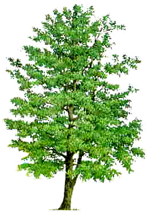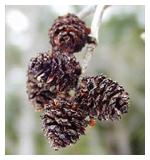Useful Information


Alder is the common name of a genus of flowering plants (Alnus) belonging to the birch family (Family Betulaceae). The genus comprises about 30 species of monoecious trees and shrubs, few reaching large size, distributed throughout the North Temperate zone, and in the New World also along the Andes southwards to Chile.
Alder leaves are deciduous (not evergreen), alternate, simple, and serrated. The flowers are catkins with elongate male catkins on the same plant as shorter female catkins, often before leaves appear; they are mainly wind-pollinated, but also visited by bees to a small extent. They differ from the birches (Betula, the other genus in the family) in that the female catkins are woody and do not disintegrate at maturity, opening to release the seeds in a similar manner to many conifer cones.
The best-known species in Europe is the Common or Black Alder (A. glutinosa), native to most of Europe and widely introduced elsewhere. The largest species is Red Alder (A. rubra), reaching 35 m (the tallest is 32 m) on the west coast of North America, with Black Alder and Italian Alder (A. cordata) both reaching about 30 m. By contrast, the widespread Green Alder (A. viridis) is rarely more than a 5 m shrub.
Traditional Uses Of Alder
The wood of the Alder is light, quite brittle when young and easily worked. It is often worked while still green and will turn well on a lathe. The cream coloured newly cut wood turns a pink orange whilst working on it. This ‘bleeding’; causes the more mature wood to be beautifully tinted and veined. It was therefore much sought after by furniture makers. In the Highlands of Scotland, it was used a lot for making chairs and thus came to be known as ‘Scottisch mahogany. Cabinet makers were especially fond of the roots and knots of Alder wood. Mrs. Grieves reports that it was also used for cart and spinning wheels, bowls, spoons, wooden heels, herring-barrel staves, etc. On the European continent it was used for cigar boxes, because of it reddish cedar like appearance. In Lancashire it was used to make clogs for the textile mill towns and it was similarly used in South Scotland. The bodgers, working in the coppices and woods, cut the green Alder into roughly the right size for clogs. They then left it to season and send the material on to the workshop to finish the clogs.
In ancient Ireland, Alder was used to make pails and other dairy equipment.
Green Alder branches can make good whistles and panpipes, an important attribute for a tree to possess in the days before mass entertainment.
Alder poles were a favourite timber for underground foundations in damp or wet conditions. It was used as piles under houses, bridges, boat jetties, canal lock gates, pumps and troughs. The ancient Roman writer, Virgil, claims that the first boats were made of Alder wood. The timber can resist decay in a wet environment almost indefinitely. Venice floats partly on the strength of Alder trees. However, it is not very good for fencing in dry land, since the wood seems to need the water to balance its fire power in order to remain solid. Alder fencing posts can rot within the year at the part between the earth and the air.
Before synthetic dyes started to come into general use, the Alder gave us some of the very finest dyes for wool and linen. The wonderful Mrs. Grieves, author of “A modern Herbal” informs us in great detail: “Both bark and young shoots dye yellow and with a little copper a yellowish -grey, useful in shadows of flesh in tapestry. The shoots cut in March will dye cinnamon, and if dried and powdered a tawny shade. The fresh wood yields a pinkish-fawn dye and the catkins green. The bark is used as a foundation for blacks, with the addition of copperas. Alone it dyes woolens a reddish colour (Aldine Red -(which was a favourite colour of our Celtic ancestors). An ounce (of bark), dried and powdered, boiled in 3/4 pint of water with an equal amount of logwood, with solution of copper, tin and bismuth, 6 grains of each, 2 drops of iron vitriol, will dye a deep boue de Paris.”
Nowadays the wood is often used as woodpulp. In the USA the timber is of considerable economic importance, as it is the third most important hardwood export in the U.S. after red and white oak. In Canadian forestry high quality red alder logs are said to be approximately equal in value to that of a douglas fir log. Red alder wood is used in the manufacture of fine furniture, specialized veneers, plywood, paper and pallets.
news!
Copyright: SERENGETI OÜ. All Rights Reserved.
serengeti[at]serengeti.ee






